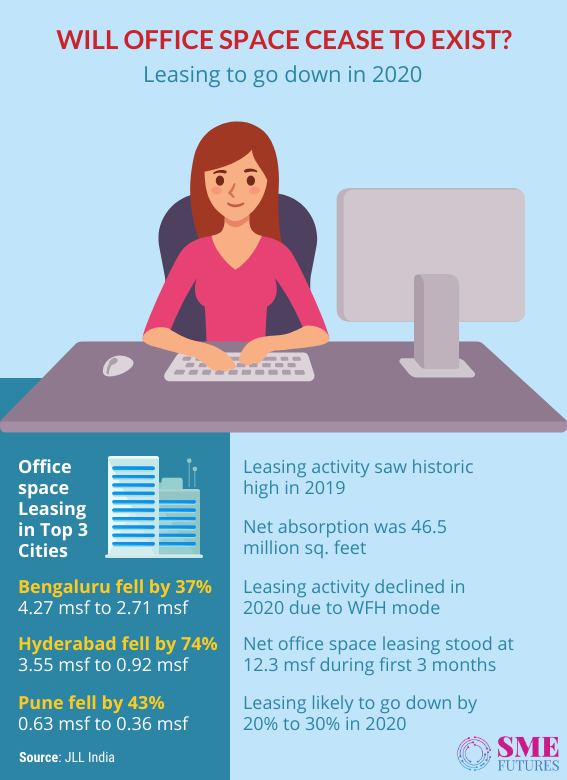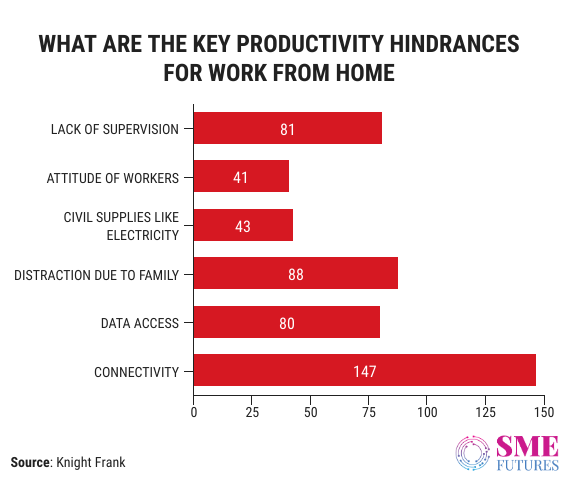As the initial phase of lockdown commenced, real-estate sector was abuzz with apprehensions in the demand of office space due to increased work-from-home scenarios. Numerous organisations including corporates, small businesses, start-ups, and gig-economy workers reduced their office spaces in order to conserve money. Hence, this impact of increasing transition into work from home models, the demand for office space is likely to fall in market by 5 to 15 per cent this year.
But, despite the fall in demand of office space, it still appears that the idea of working in a brick-and-mortar model is not going to lose its sheen. The real estate experts and consultants tell that this is primarily due to challenges posed by remote working such as productivity, data privacy, cyber attacks, infrastructure etc.
JLL India CEO and Country Head, Ramesh Nair says, “Considering work-from-home challenges such as teamwork, performance management, productivity, creativity, data privacy, apartment sizes, office infrastructure and connectivity, we believe office demand could be impacted anywhere between 5-15 per cent in the medium term.” Considering the current headwinds, it is a minimal impact on the office demand and its occurrence would also be in medium term.
Most of the industry experts believe that the office space is here to stay. In fact, in some cases there may be an expansion of office spaces owing to physical distancing norms implemented by organisation among their employees. The current office configurations will then be modified resulting in an increase for additional space.
Occupiers during this process may consider tapping flexible spaces from third-party operators, along with ongoing remote working for some employees. Anarock Chairman, Anuj Puri opines, “WFH is not a catch-all solution, many business verticals and functions still require employees to work in an office setting.”
A large chunk of work needs constant monitoring and professional infrastructure which only an office setting can provide. He further adds, “There are several socio-economic and logistical advantages of working from offices which may not be replicable in a WFH setting. Companies will particularly need to figure out the equation on employee productivity, morale and overall branding.”
Knight Frank India, CMD, Shishir Baijal adjudges work-from-home as an alternative workplace strategy. He reclaims, “Social distancing is here to stay, till a viable treatment for COVID-19 is found, which will require office users to maintain or acquire more space to accommodate the existing team.”
On a similar note, Dr. Kumar R, CMD, Navin Housing & Properties also think that WFH is not a long term alternative. He professes, “Due to COVID-19 lockdown, offices remained closed and even after partial lift of lockdown workplaces are operated with minimal staff. People are encouraged to work from home also. While Work from Home (WFH) can be an option, it is not a solution for running offices. However, when normalcy returns the impact on office space will be partial and minimal.”
Leasing of Office Spaces Will Now Decrease
There has been a gradual decrease in leasing activities from the time lockdown commenced as work from home became the new normal. According to JLL India’s Chief Economist and Head of Research, Dr. Samantak Das said leasing which is a surrogate for office spaces is going to go down for some time now.
However, India’s office market across seven major cities has remained resilient in the first quarter of 2020 despite challenges. Dr Das tells, “In 2019, leasing activities grew on its historic high. The net absorption stood at 46.5 million sq. feet (msf) across the top seven cities; while overall supply was 52 msf for grade ‘A’ office spaces. Due to the ongoing crisis and increasing WFH mode, the annual leasing may likely to go down by 20 to 30 per cent in 2020.”
The net office space leasing stood at 12.3 million sq ft during the same period an year ago. However, the new supply of office space fell 40 per cent to 8.6 million sq. ft during the first three months of this calendar year. According to the JLL report, office space leasing in Bengaluru fell 37 per cent to 2.71 msf from 4.27 msf. Hyderabad saw a fall of 74 per cent from to 0.92 msf from 3.55 msf, when demand of the office space in Pune dipped to 0.36 msf from 0.63 msf.
Office space leasing in Kolkata plunged 98 per cent to 0.02 msf from 0.88 msf. On the other hand, office space absorption in Chennai increased to 0.92 msf from 0.44 msf. Delhi-NCR too saw marginal increase in leasing to 1.55 msf from 1.51 msf. Lastly, office space leasing in Mumbai jumped to 2.14 million sq ft from 0.98 msf.
“With fresh take up of spaces likely to be limited during the next couple of months, landlords might have to sit on locked-in capital (completed buildings) for a relatively longer period of time,” Das further opines. According to him, it is likely that office space market may not see such spike in next coming three years.

Impact on Flexible Spaces and Co-working
Concept of co-working spaces mainly thrives with small businesses, start-ups, or gig workers. The share of co-working operators in total Grade ‘A’ office leasing increased from merely 5 per cent in 2017 to around 13 per cent in the first quarter of 2020. With the success of co-working concept, many new players entered the bandwagon of this cost-effective alternative. Today, there are more than 350 co-working players in India.
These organisations are witnessing a major drop in footfall currently with clients backing off from rental seats and hence they have become in limbo. This is due to prolonged lockdowns and an exponential increase in coronavirus cases. However, operators and experts believe this trend could be temporary and demand for flexible space would rise again because of many positive key factors associated with them.
Kumar R, Chairman & Managing Director, Navin’s advocates the perception. He proclaims, “Co-working as a concept, has come to stay to enable small businesses and startups which cannot afford offices of their own in the locations they operate. Though there will be some hiccups due to COVID-19 in the short term; this concept will survive and grow in longer run.”
But challenges remain intact for the sector, which has shown remarkable growth in recent years. It is also seen by many as a catalyst in the arena of modern office spaces. This is because of the reason that large corporates are still wary of depending on them for their expansion, citing restrictions and limitations.
Co-working spaces need to re-think their strategies more than ever now. Consolidation by giving up spaces or tying up with larger players will fetch pace for unorganised operators. Necessary design changes will also play an important role in adapting to the post COVID-19 norms of physical distancing. The more reputed and organised operators might have to put enhanced focus on managing office spaces and neighborhood centers.
Manas Mehrotra, Chairman of a co-working firm 315Work Avenue adds, “With many employees working from home currently and amidst indications that a significant section of them would continue to do so even after the return of normalcy, co-working space providers would now have to rethink their strategy, particularly as far as workplace, interior and design areas is concerned. They will also have to make the segment more attractive for consumers.”
Considering the situation co-working companies might follow a hub-and-spoke model. This will lead to splitting up of offices and increasing demand of office spaces that are closer to residential neighborhoods. With corporate occupiers looking at deferring any kind of capital expenditure in the short to medium term, there is likely to be an increased demand for managed office spaces. Hence, co-working operators can tap this section in the coming period.
Speaking about the evolving strategies in this arena, JLL’s Das opines, “Co-working space needs a total turn around in their business structure. Earlier, it was all about pure play but in the post COVID-19 world, intense de-densification will happen as we can’t afford to have a small office. Firms now will need more area per sq. feet for each employee and it will be a new normal which is imperative to contain the virus.”
Overall, COVID-19 induced new normals would include social distancing; reduce desk sizes; open work stations; sitting spaces six-feet apart from each other, and better air-conditioning infrastructure. Adding in it, Mehrotra said the co-working industry might also see some consolidation soon and companies will thereafter explore acquisition opportunities. The current situation will also see larger enterprises seeking smaller spaces to ensure synergised business continuity in near future.
Remote Working Not Being Effective Always
Despite a seemingly successful work-from-home experiment globally, offices will continue to be sought after in our region. Although the pandemic has shifted perceptions around the effectiveness of remote working, it is yet not perceived as a sustainable or optimal long-term solution for all organisations.
Working from home poses several challenges both for employer and the employee. A recent Knight Frank Survey among corporate real estate executives (CRE) to understand the changed workplace dynamics provides three main challenges while working remotely among others. These are connectivity, distraction due to family, and lack of supervision in hindering productivity.

Anshul Jain, MD (South East Asia and India), Cushman and Wakefield, said that one must not overlook the fact that most individuals don’t have the ideal work conditions at home. He says, “Our current situation has forced us to work from home and we all have done a splendid job without a doubt. But, it was always accepted that this was temporary and there weren’t any distractions.”
“Most people are looking forward to going back to the office, reclaiming the routine, and getting back the human interaction in their work lives,” he adds further. Office spaces will always be preferred for accomplishing tasks such as closed-door meetings, collaborations, research, data protection, speed, tech-infrastructure, and discussion of managerial issues.
No Replacement of Office Spaces
Currently, work from home is the best substitute to conventional way of working from in a brick-and-mortar office. It could hence impact the office market demand by up to 15 per cent in the medium to long term, JLL data states. Increasing demand for office spaces from emerging sectors such as healthcare, FMCG, e-commerce, and data centres will act as new growth drivers of office demand.
On this, Dr. Samantak Das opines, “There are other sectors such as FMCG, OTT platforms, Data centers, e-commerce etc that are gaining strength by leaps and bound currently. They will gradually increase demand and will somewhat compensate for the present office space degrowth.” Adding to this, Kumar of Navin’s says, “The only impact I see in office space is the increase in size of spaces required per person to maintain a decent spacing between two employees. In fact, it might trigger the demand for a larger office space than at present.”
The office space demand will nevertheless boost up in few quarters according to experts. “The impact will subside in due course of time with the step by step lifting of the lockdown. Once all markets, stadia, movie halls and malls as well as transportation services are restored, near normalcy will tread its way back. It may take probably a few quarters to happen.” adds Kumar.
Restoration of normalcy also depends on the impact of economic stimulus along with cash availability for the afflicted sectors in the economy. The short-term slackening in demand are the challenges that need the immediate attention of policy-makers. However, the fundamentals of office market still remain strong, with low vacancy, stable rental growth, and limited upcoming supply in the next few years.
Office space demand hence will be first one to recover followed by the residential sector. Knight Frank’s Baijal concludes, “Work from home will co-exist, but office space will not lose its importance as a strategic tool for corporate culture development and a source of competitive advantage. Going forward, more formulae will be devised especially in the post -pandemic phase which will include strategies such as Work from near Home. This will in the long term, ensure there will be developments of offices not only in the top eight cities but also in smaller towns too where employees originate from.”











